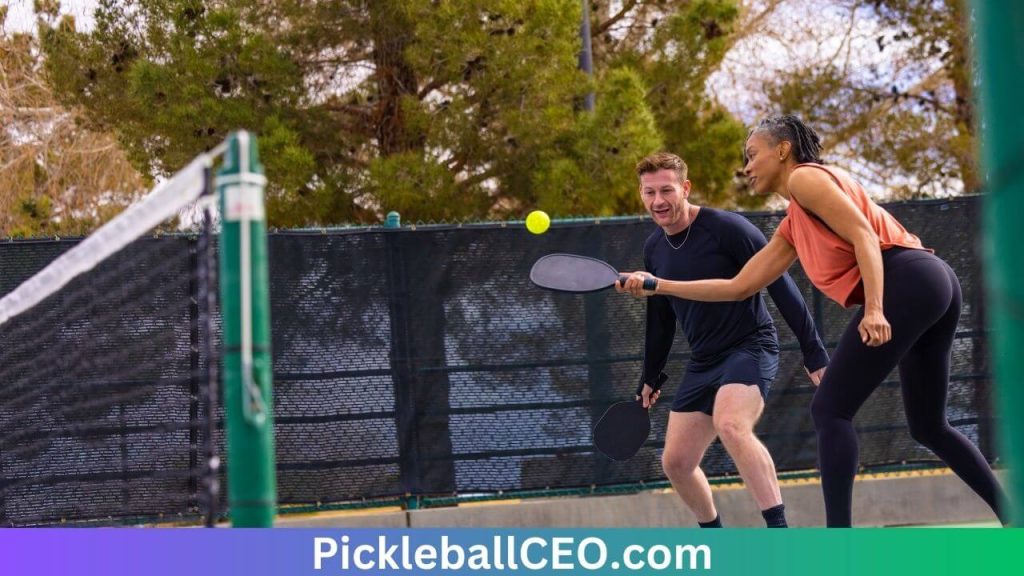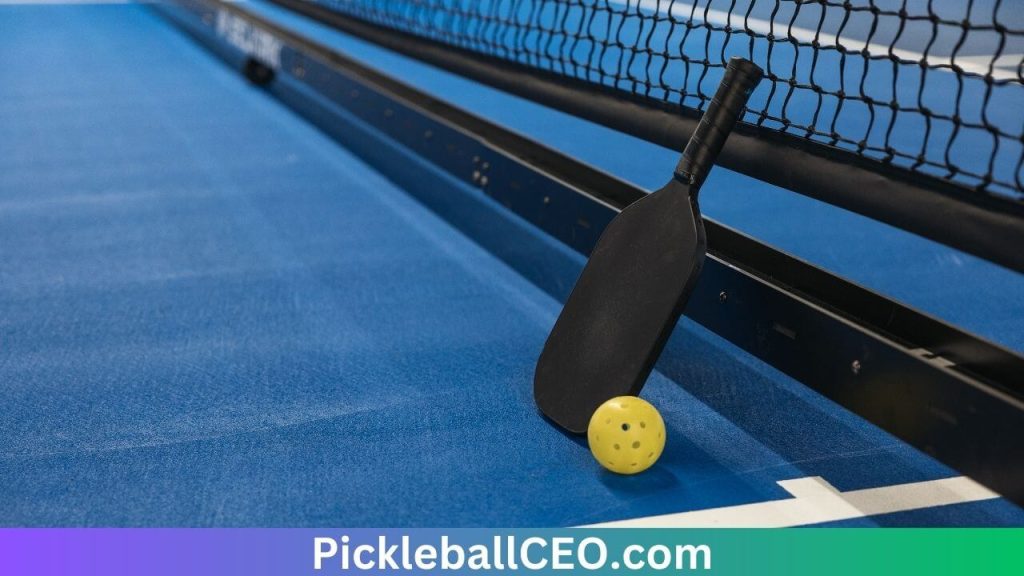1. Timing and Placement


The timing and placement of your offensive lob are crucial for its success. This step involves waiting for the right moment and aiming for the optimal location to put pressure on your opponent. Here’s a breakdown of the key aspects:
Wait for your opponent to move forward:
Before executing the offensive lob, you want to observe your opponent’s positioning on the court. Ideally, you want them to move forward towards the non-volley zone, also known as the kitchen. This is typically done after they hit a shot or during a rally when they try to gain control of the net. By waiting for them to move closer to the kitchen, you increase the effectiveness of the lob as it forces them to move back quickly to reach the ball.
Aim high and deep:
Once your opponent is in or near the kitchen, it’s time to hit the offensive lob. The goal is to hit the ball high and deep into your opponent’s side of the court. The lob should be aimed close to the baseline, which is the farthest point from the net. By hitting the ball deep, you force your opponent to retreat towards the baseline, giving you more time to recover and regain control of the rally.
Pressure your opponent to move back:
The offensive lob puts your opponent in a challenging position as they have to quickly move back from the kitchen towards the baseline to retrieve the high shot. Moving back requires time and effort, which can disrupt their rhythm and potentially create an opportunity for you to regain control of the rally. By forcing your opponent to move back, you gain an advantage and increase your chances of winning the point.
Reset the rally:
Once you have successfully executed the offensive lob, it’s important to be ready for the next shot. After your opponent retrieves the lob, the rally will likely reset, and both players will be back in a neutral position. Use this opportunity to reposition yourself, anticipate your opponent’s return, and prepare for your next shot. The offensive lob is a strategic shot that helps you regain control of the point and create opportunities for a favorable outcome.
Remember, timing and placement are key factors in executing a successful offensive lob. Practice and experience will help you develop a sense of when to hit the lob and how to place it effectively, increasing your chances of winning points and gaining an advantage in the game.
2. Spin and Speed


Incorporating spin and speed into your lob can enhance its effectiveness and make it more challenging for your opponent to handle. By manipulating the spin and speed of the ball, you can create different trajectories and make it harder for your opponent to execute an offensive shot.
Adding Topspin:
Adding topspin to your lob can help the ball clear the net and then dip down quickly, making it more difficult for your opponent to attack. When you hit the ball with topspin, you impart a forward spin that causes the ball to rotate from top to bottom. This rotation creates a downward force on the ball, making it drop faster after it clears the net.
The topspin lob is particularly effective when executed with proper timing and placement. By hitting the ball with topspin, you increase the likelihood of your lob landing deep in your opponent’s court, closer to the baseline
Using Backspin:
Alternatively, you can use backspin to slow down the trajectory of your lob. When you hit the ball with backspin, the rotation goes from bottom to top, creating a backward spin. This spin causes the ball to slow down in flight, giving your opponent less pace to work with.
The backspin lob can be effective in situations where your opponent is positioned close to the net, as it can force them to retreat and give you time to reset the rally. By employing backspin, you can also make the ball bounce higher, making it more difficult for your opponent to execute an aggressive shot.
It’s important to note that mastering the control of spin and speed takes practice. Experiment with different angles of contact, paddle face positions, and follow-through to find the right spin and speed combination that works best for your offensive lob.
3. Change of Pace


Varying the pace of your lob can be a highly effective strategy to catch your opponent off guard and disrupt their rhythm and timing. By alternating between fast and slow lobs, you make it harder for them to set up for an offensive shot, increasing your chances of gaining an advantage in the rally. Let’s break down this step further:
- Purpose: The primary goal of changing the pace of your lob is to create uncertainty and make it difficult for your opponent to anticipate the trajectory and timing of the shot. It forces them to constantly adjust their positioning and shot preparation, potentially leading to errors or weaker returns.
- Fast Lobs: Executing a fast lob involves hitting the ball with more power and speed. This type of lob can catch your opponent off guard, especially if they are not expecting a shot with a higher velocity. A fast lob can be effective in pressuring your opponent into a defensive position, limiting their ability to counterattack.
- Slow Lobs: On the other hand, a slow lob is characterized by a softer touch and reduced speed. This type of lob can be used strategically to disrupt your opponent’s timing. A slow lob gives you more control over the ball’s placement, allowing you to position it closer to the baseline or target specific areas of the court that are harder to reach.
- Execution: To execute a change of pace effectively, mix up your lob shots during the rally. For example, you can start with a fast-paced lob to push your opponent back and then follow it up with a slower lob that drops closer to the baseline. Alternatively, you can begin with a slow lob to throw off your opponent’s timing and then surprise them with a sudden fast-paced lob.
- Timing and Observation: Pay close attention to your opponent’s positioning, movement, and shot preparation. Observe their reactions to your lobs and adjust your strategy accordingly. If they seem uncomfortable with fast-paced shots, continue to utilize them. If they struggle with slower lobs, exploit that weakness. Timing is crucial, so try to execute the change of pace at the right moment to maximize its effectiveness.
Also Read: 3 of the Craziest Pickleball World Records
By incorporating a change of pace into your offensive lob shots, you create an element of surprise and make it challenging for your opponent to anticipate and respond effectively. This strategic variation can lead to winning points and gain you an advantage in the game. Practice this skill to become proficient in adjusting the lob’s pace and observing your opponent’s reactions to exploit their vulnerabilities.
4. Body Language Deception


Using your body language to deceive your opponent can be a powerful tactic in executing an offensive lob. By pretending to hit a hard shot or a dink, you can create confusion and force your opponent to make a quick adjustment, increasing the chances of a successful offensive lob.
Setting up the Deception:
The first step in body language deception is setting up the shot. Initially, position yourself as if you are preparing for a hard shot or a dink. Your body posture, paddle position, and overall stance should reflect your intention to hit a different shot.
Mimicking a Hard Shot or Dink:
Next, mimic the body language and movement patterns associated with a hard shot or a dink. This includes engaging your body and paddle as if you are about to execute the intended shot. This step is crucial in convincing your opponent that you are about to hit a specific type of shot.
Last-Minute Adjustment:
At the last moment, when your opponent has committed to their defensive positioning based on your initial body language, quickly adjust your shot selection and execute an offensive lob instead. This sudden change of shot type can catch your opponent off guard, as they will have to readjust their positioning and footwork to handle the unexpected lob.
Creating Confusion:
The purpose of the body language deception is to create confusion in your opponent’s mind. By making them believe that you are hitting a different shot, you force them to react and adjust their positioning accordingly. This split-second hesitation or adjustment can disrupt their timing and make it more challenging for them to effectively defend against the offensive lob.
Increasing the Success of the Offensive Lob:
By using body language deception, you increase the chances of a successful offensive lob. The element of surprise, combined with the quick adjustment forced upon your opponent, gives you an advantage in executing the lob effectively. Their delayed reaction may lead to a less effective defensive response, providing you with an opportunity to place the lob strategically and put pressure on your opponent.
Remember to practice body language deception to make it more natural and convincing. It is essential to maintain consistency in your initial setup and execution of the deception to make it more effective in catching your opponent off guard.
Defending the Offensive Lob
- Anticipate the Shot: Watch your opponent’s body position and paddle angle to anticipate a potential lob. If they are positioned deep in the court or are hitting the ball with an upward paddle angle, be prepared for a lob and adjust your positioning accordingly.
- Quick Retreat: As soon as you recognize the lob, start moving backward towards the baseline. Take small steps to maintain balance and be prepared to pivot quickly in any direction.
- Positioning and Footwork: Position yourself so that you have enough space to track the lob without backing into the fence. Maintain good footwork and keep your weight forward to react quickly to the lob and move towards the optimal position for a strong return.
- Overhead Smash or Defensive Lob: Depending on the height and trajectory of the offensive lob, you can choose between an overhead smash or a defensive lob. If the lob is within reach and at a comfortable height, execute an overhead smash with power and precision. If the lob is too high or deep, consider hitting a defensive lob to reset the rally and regain control of the point.
Also Read: Mastering the Game: 3 Key Steps to Defeat Bangers in Pickleball
Conclusion
Mastering the offensive lob in pickleball requires a combination of skill, strategy, and deception. Timing and placement are crucial, as you need to wait for your opponent to move forward towards the kitchen before executing the lob and aim to land it deep near the baseline. Incorporating spin and speed into your lob can make it more challenging for your opponent to handle. Adding topspin can create a fast-dropping shot, while backspin can slow down the trajectory and make it harder to attack.
Varying the pace of your lobs can catch your opponent off guard and disrupt their rhythm. Mixing fast and slow lobs during the rally can create uncertainty and force your opponent to constantly adjust their positioning and shot preparation. Body language deception is another effective technique to confuse your opponent. By pretending to hit a different shot and then executing a lob at the last moment, you force your opponent to make quick adjustments, increasing the chances of a successful offensive lob.
On the defensive side, it is important to anticipate the offensive lob by observing your opponent’s body position and paddle angle. Quick retreat and proper footwork are essential to react to the lob and position yourself optimally for a return. Depending on the lob’s height and trajectory, you can choose between an overhead smash or a defensive lob to counterattack or reset the rally.
By incorporating these pro tips and strategies into your game, you can enhance your offensive lob execution and improve your ability to defend against it. Practice, experience, and adaptability are key to mastering these techniques and becoming a more effective pickleball player.







Comments (4)
7 Strategies to Master the Pickleball Third Shot Dropsays:
July 14, 2023 at 5:53 am[…] To improve your pickleball third shot drop, it’s essential to avoid being predictable. By incorporating different types of shots, you can keep your opponents guessing and off-balance. Here are some key strategies to vary your shots effectively: […]
Dinking in Pickleball Like The Pros Mastering the Art - Pickleball CEOsays:
July 14, 2023 at 9:32 am[…] and exploiting your opponent’s weaknesses is an effective strategy in all aspects of pickleball, including dinking. Observe their movement, footwork, and shot […]
5 Tips to Hit an Offensive Lob Shot in Pickleball - Pickleball CEOsays:
July 15, 2023 at 3:22 am[…] hit an effective offensive lob, it’s crucial to have proper footwork and positioning. Here are some key points to […]
5 of the Best Pickleball Drills to Improve Your Game - Pickleball CEOsays:
July 19, 2023 at 11:57 am[…] lob and smash drill is an effective way to enhance both your defensive and offensive skills in pickleball. This drill focuses on your […]